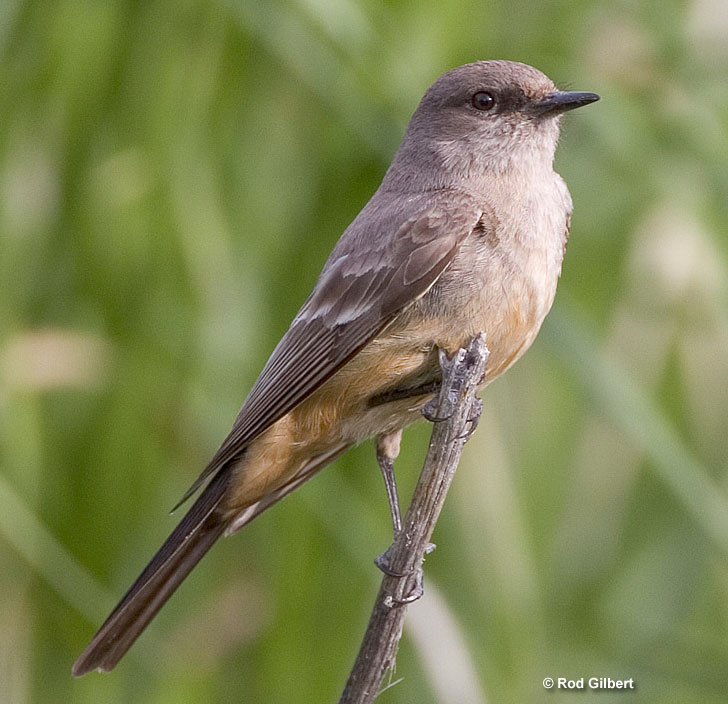Say’s Phoebe (Sayornis saya) is a smallish insectivorous flycatcher native to western North America. They have brownish-gray upperparts and pale cinnamon underparts.
You can find them in dry, open to semi-open habitats and recognize them by their slurred whistles and by their habit of flicking their tails up and down. Discover more about this common yet sweet bird!
On this page
Identification
Say’s Phoebe has a relatively plain yet charming appearance. They’re on the smaller side, about 6.5-7.5 inches long with a wingspan of 13 inches. You can recognize one by their often flat-looking head and constant tail flicking.
Their plumage is typically brownish-gray on the upperparts and pale cinnamon-colored on the underparts with a gray breast. They have a slightly darker, almost black tail. Their black bills are relatively short, and their wings are long and pointed.
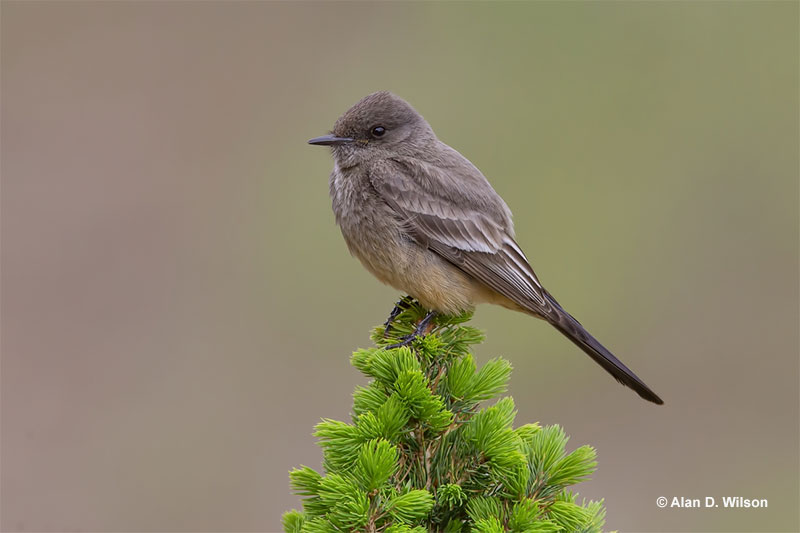
Males and females look alike. Juvenile Say’s Phoebes look similar to adults. They have grayish-brown upperparts, pale rusty underparts, and cinnamon-colored wingbars.
Vocalizations
Say’s Phoebe’s song and call are simple, consisting of a series of soft, monotonous whistles and chirps.
Their song consists of two syllables that may sound like pee-ur, of which the first sound is slurred. The phrase lasts less than a second, but they repeat it over and over.
They also have a flight song, which is a rapid series of slurred whistle-notes. Their calls can be simple and monotone whistles but also slurred chatter.
Food
Say’s Phoebe’s diet consists almost entirely of insects. They eat flies, crickets, beetles, grasshoppers, moths, and dragonflies, and seem keen to eat bees, winged ants, and wasps. On occasion, they snatch up millipedes and spiders, rarely also berries.
They mostly perch somewhere near the ground, on a rock or in low shrubs and trees, and dash out to catch their prey mid-air. You may also see them hovering over fields or pouncing on insects that are on the ground.
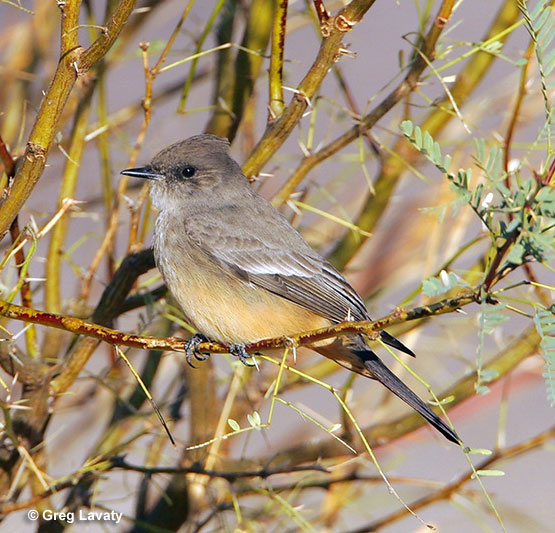
Say’s Phoebe
Nesting and Eggs
Arriving before females, male Say’s Phoebes establish their breeding territories and defend it by singing from an exposed perch. The pair looks for a suitable nesting place together.
They prefer to nest in places that have shelter or a ledge over them. You can find it in various places and at varying heights from rocky ledges and crevices in cliffs to holes within banks or trees to the undersides of eaves and bridges.
The female Say’s Phoebe is the one building the nest. Say’s Phoebe’s nests are flat open cups of grass, weeds, rocks, moss, and spiderwebs. They line it with finer materials such as wool, paper, hair, and feathers.
The finished nest measures about 6 inches in diameter. If they decide to reuse or “hijack” another bird’s nest, they add fresh lining material.
These flycatchers can have 1-2 broods in a year with 3-7, mostly 4 eggs in a clutch. Say’s Phoebe eggs are white and mostly unmarked, although some may have reddish spots. They measure 0.7-0.9 inches long and 0.6-0.7 inches wide. Females incubate the eggs for 12-18 days and both parents feed the nestlings.
Younglings leave the nest as early as 13 days after hatching but it may take up to 21 days.
Current Situation
Say’s Phoebe ranges throughout western North America and Mexico. They breed in Alaska, western parts of Canada, and the northwestern United States.
In the southwestern United States and parts of Mexico, they are year-round residents. Birds breeding in the northern areas migrate south to the southwestern United States or Mexico for the winter.
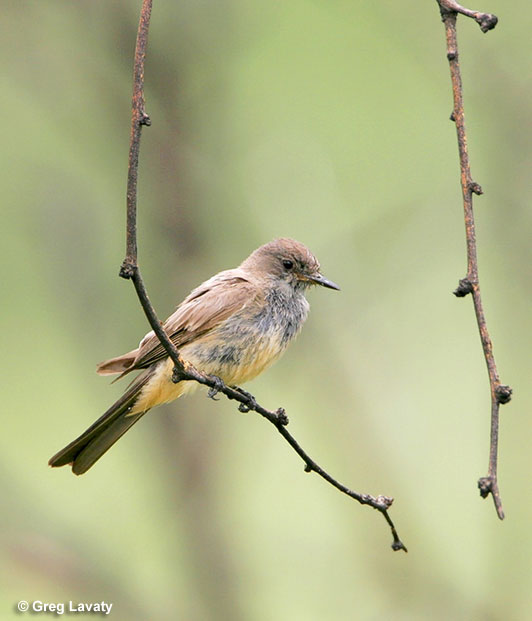
These flycatchers like to live in very dry open to semi-open areas. Say’s Phoebe habitats include canyons, scrub, prairie, savannah, farmland, dry upland tundra, badlands, barren foothills, and borders of deserts. They avoid forested areas.
According to the IUCN Red List, Say’s Phoebe is a species of least concern. They are widespread and numerous, and their population has shown a slight increase.
Facts
- This species has been around for a long time. The fossils found in the United States date back to the late Pleistocene era.
- Say’s Phoebes cough up pellets that contain parts of insects they weren’t able to digest.
- Say’s Phoebe is named after Thomas Say, an American naturalist who first discovered the bird in 1819.
- Say’s Phoebes reuse a good nesting site year after year. They may nest in very peculiar places, including in mailboxes, wells, and mine shafts.
Similar Species
Say’s Phoebes are similar to other small and modest flycatchers but also female bluebirds. We have introduced four of the most similar species and how to distinguish them.
Vermilion Flycatcher
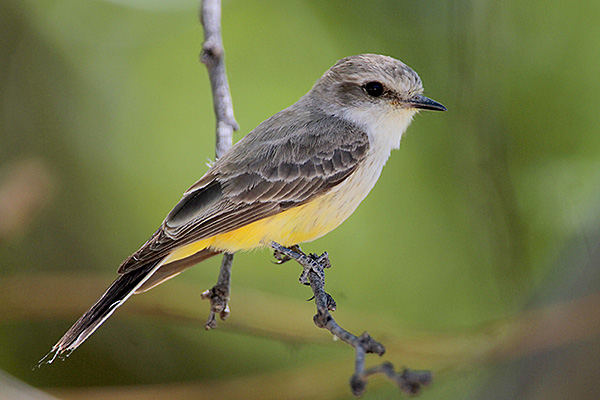
Adult female Vermilion Flycatchers look very similar to Say’s Phoebe. However, they have a reddish belly instead of a pale rust-colored one and a white, dark-streaked breast instead of a uniformly gray one.
They also have shorter wings and tails.
Eastern Phoebe
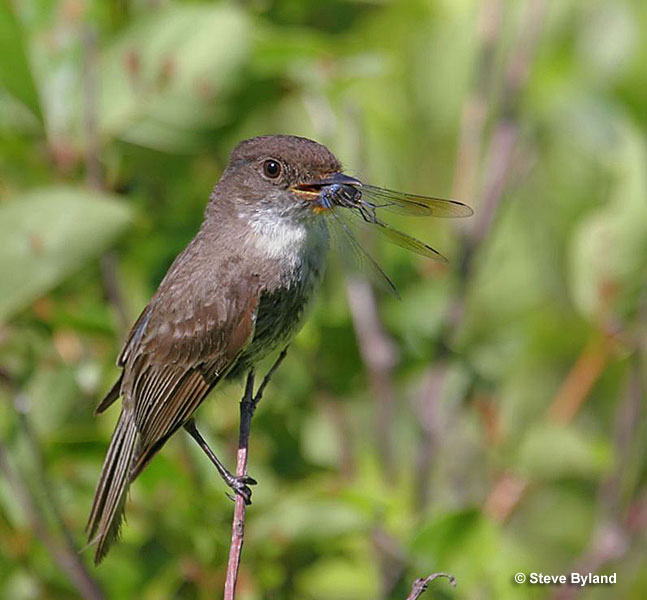
Comparing the two, Eastern Phoebe has a whitish underside, whereas Say’s Phoebe has a pale cinnamon-colored underside and gray breast.
Eastern Phoebes are also a bit darker above.
Frequently Asked Questions
What does a Says Phoebe look like?
Say’s Phoebe looks rather modest. They’re small and have a brownish-gray upperside, pale cinnamon-colored belly, and gray breasts.
How big is a Say’s Phoebe?
Say’s Phoebe is about 6.5-7.5 inches long with a wingspan of 13 inches.
What does a Say’s Phoebe eat?
Say’s Phoebes almost exclusively eat insects, including flies, moths, grasshoppers, beetles, bees, etc. They may also take spiders and rarely berries.
What sound does Say’s Phoebe make?
Say’s Phoebes produce soft, almost monotonous, slurred whistles.
What is the difference between a Say’s Phoebe and an Eastern Phoebe?
Eastern Phoebe has a white underside and is a bit darker above, whereas Say’s Phoebe has a pale cinnamon-colored underside and a gray breast.

